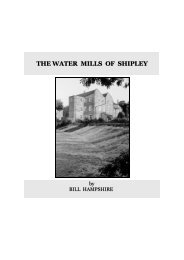IN THE SHADOW OF THE ROSSE - Shipley
IN THE SHADOW OF THE ROSSE - Shipley
IN THE SHADOW OF THE ROSSE - Shipley
Create successful ePaper yourself
Turn your PDF publications into a flip-book with our unique Google optimized e-Paper software.
December of the same year they were told to keep their w.c’s in good repair, and when<br />
the repairs were not done within the specified time they were threatened with prosecution.<br />
22<br />
All the evidence above suggests that, in order to maintain standards, the local authorities<br />
had to keep a continual check on the housing situation throughout the town. Even<br />
when it involved, what might be assumed to have been, a respectable business such<br />
as a building society.<br />
In 1885, the Bradford Commercial Joint Stock Banking Company sold a plot of land at<br />
the junction of Ashley and Bingley Roads to the Windhill Independent Co-operative Society<br />
[16]. Permission was then given by the Local Board for the building of two shops<br />
and three houses on the site. The Ordnance Survey map of 1889, shows that the three<br />
houses, two in Ashley Road, and one fronting onto Bingley Road, were built first. Some<br />
time later, the Bingley Road house was converted into a shop, and an additional building<br />
was added to its side. The whole block then consisted of: a butchers, a grocers and a<br />
drapers. They survived as such until the demolition in the 1960s, albeit with the grocer’s<br />
having been converted into one of the new self-service ‘supermarkets’, not too<br />
long before the demolition.<br />
Over the next few years things seem to have improved for the Rhodes firm. Elizabeth<br />
Ann Rhodes started to buy back much of the land taken under the control of the Bradford<br />
Commercial Bank at the time of the bankruptcy. In January 1890 Mrs Rhodes, operating<br />
as Rhodes Brothers, received permission to build a block of 8 back-to-back<br />
houses in Ashley Road, just behind the Co-op [17]. A year later the firm built a second<br />
block of 7 houses adjoining [18]. The houses were financed by a mortgage for<br />
£1000 taken out with Mr Robinson Bramley of Outwood Hall, Wakefield.<br />
These houses were different from earlier ones that the firm had built, in that the ‘back’<br />
houses faced into an enclosed yard. Prior to this time all the houses constructed on this<br />
site had faced out onto their own streets, with the majority of the houses having their<br />
own yard and lavatory. In this particular case, each pair of houses, front and back, had to<br />
share a lavatory, as, indeed, did those who lived on the opposite side of Ashley Road. Presumably,<br />
these houses were designed for tenants who required a lower rental accommodation<br />
than those who took the earlier houses [see below].<br />
The lavatory blocks were situated within the enclosed yard, and were sited only a few<br />
feet away from the houses they were to serve. The lavatories themselves were below<br />
ground level and were accessed by a flight of steps.<br />
On completion, in 1891, both blocks of houses were sold to Mary Hannah Brooksbank,<br />
the wife of Alfred Brooksbank of <strong>Shipley</strong>. Mrs Brooksbanks sold all her Ashley Road<br />
properties to Sir Titus Salt Bart and Sons Ltd. in 1920, at a time when several textile<br />
mills were expanding their housing interests. Elizabeth Ann Rhodes also sold another<br />
small block, [29], to the Saltaire firm at the same time.<br />
Following her sale to Mrs Brooksbank, Elizabeth Ann Rhodes bought another plot<br />
from the Bradford Commercial Joint Stock Bank, an area of 1600 sq yds, bounded by Oastler<br />
and Bingley Roads [19,20]. A row of five wooden shops were erected on that part<br />
of the site fronting Bingley Road [19]. Among the first occupants of these shops was a<br />
confectioner, a hairdresser and a plumber. There was also a small stable at the Oastler<br />
Road end. Behind these shops were the remains of an old quarry. This land was never<br />
developed and remained as waste land until the time of the modern re-development.<br />
14



